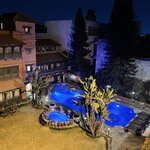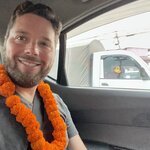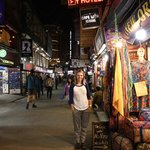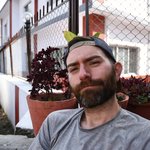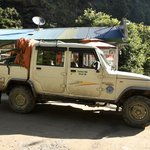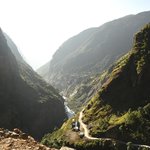
Nar Phu Valley Trek - 12 Days

Highlights
- Venture into a remote part of Nepal that few travelers get to see
- Stay in ancient villages that have seen little change over the centuries
- Enjoy great views of Annapurna II, Himlung Himal, Gangapurna, and Tilicho Peak
- Experience a part of the Tibetan plateau that extends down into Nepal
- Witness a Tibetan-derived culture, with unique and colorful prayer stones and monasteries
Brief Itinerary
| Day | Highlights | Overnight |
|---|---|---|
| Day 1 | Welcome to Kathmandu! | Kathmandu |
| Day 2 | Explore Kathmandu | Kathmandu |
| Day 3 | Drive from Kathmandu to Koto (8,530 feet / 2,600 m) | Koto |
| Day 4 | Trek from Koto to Meta (11,680 feet / 3560 m) | Meta |
| Day 5 | Trek from Meta to Phu (13,386 feet / 4080 m) | Phu |
| Day 6 | Acclimatization day in Phu (13,386 feet / 4080 m) | Phu |
| Day 7 | Trek from Phu to Nar Phedi (11,450 feet / 3490 m) | Nar Phedi |
| Day 8 | Trek from Nar Phedi to Nar (13,484 feet / 4110 m) | Nar |
| Day 9 | Trek from Nar to Ngawal (17,192 feet / 5240 m) via the Kang La Pass (5,240m) | Ngawal |
| Day 10 | Trek from Ngawal to Pisang, Drive to Besisahar (8,179 feet / 2,493 m) | Besisahar |
| Day 11 | Drive from Besisahar to Kathmandu | Kathmandu |
| Day 12 | Depart Kathmandu |
Overview
The trek through the Nar & Phu valleys combines high peaks and passes, glaciers, remote villages, narrow canyons, lovely forests, amazing rock formations, yaks, gompas and unique ethnically Tibetan cultures. Closed to trekkers until late 2002, very few outsiders have explored these virtually untouched villages or climbed the many 7000 meter peaks surrounding them.
Starting at Besisahar — the traditional starting point of the Annapurna Circuit — the trek quickly diverges from routes with more foot-traffic and into the remote Nar & Phu valleys. Passing colorful Tibetan chortens and prayer stones into deep canyons and gorges, you will get the chance to hang out with villagers in Phu while they go about their daily activities, as well as spend a night in the Nar Phedi monastery. These are ideal ways to learn about life deep in the mountains of Nepal. There is also the option to hike up to Himlung Himal Base Camp if you’re feeling up to it.
The last couple of days of the trek take you over the high Kang La Pass, and then down again to Ngawal, a popular stop on the main Annapurna Circuit route, thus giving you a chance to enjoy some ‘home comforts’ again. The surroundings become greener and more fertile on the last stretch, before returning by vehicle to Besisahar.
Chat with a local specialist who can help organize your trip.
Detailed Itinerary
Day 1: Welcome to Kathmandu!

Flying into Kathmandu, you'll have views of the Himalaya and of the terraced fields and hillsides, below. After completing customs, a representative will be waiting to greet you and drive you to your hotel.
After you've settled in, you'll have time to explore the city. Recommended sights to see on your first day include Kathmandu’s Durbar Square and its narrow alleyways teeming with small shops, ancient temples, and local restaurants, and also Swayambhunath temple, where you can watch the sunset over the valley and the Himalaya to your north.
The tourist hub of Thamel is a good place to grab your first meal, with a variety of restaurants to chose from offering both Western and local Nepali dishes.
Day 2: Explore Kathmandu

Kathmandu has a special atmosphere during the early morning hours when the city is slowly coming to life yet not too chaotic. It's a great time to walk and explore the streets or have a chai overlooking one of the local courtyards or durbar squares.
After breakfast, there are then a number of ways you can spend your day given the numerous famous sights around the Kathmandu Valley. You can use this as a free day or we can provide a local English-speaking guide who knows the city well and can explain the history and significance of the sights (along with a private jeep to take you around).
Later in the evening, head out for dinner at one of the city's great eateries, or your specialist can arrange a home-cooked dinner with a local family.
Day 3: Drive to Koto

Leave Kathmandu early and drive first to Besisahar. After lunch, change to a four-wheel drive vehicle for the rugged journey to Koto. The road can be almost as challenging for passengers as for drivers, but it is incredibly scenic! It travels along the old Annapurna Circuit trek route, through amazing gorges and past stunning waterfalls. Arrive in Koto in time for dinner.
Day 4: Trek to Meta

Start the day early, as there is a lot of distance to cover. Cross the river and enter the Nar & Phu valleys. Towns on the nearby Annapurna Circuit are relatively well developed, but this is not the case in these valleys.
Today’s trekking route passes through beautiful woods, past small cave shelters and pilgrims’ resting places. Emerging from a narrow canyon, the trail passes under a wide waterfall, from which point the woods become thinner and the vistas wider. The last stretch into Meta involves climbing a steep hill, from which there are amazing views of some of the giant snowy peaks in the area.
Meta lies on a big open plain and consists of a few lodges, which are simple but clean and offer good meals.
Day 5: Trek to Phu

Trekking out of Meta, some of the unique, colorful Tibetan Buddhist chortens that Nar and Phu are famous for begin to appear in sight. The trail meanders along the ridge with a good view of the magnificent Nar Phedi Monastery, where you will stay in a few days’ time. After another ninety minutes hiking through scenic canyons and gorges, you’ll reach a monolith that guards the steep trail up to Phu.
From here, you can get your first view of the three villages in the area as well as the old “dzong” (Tibetan-style fortress) and the remains of two ruined forts, impressively situated atop the flatlands before the village. Just before crossing the bridge into Phu, a line of wonderful chortens color the landscape.
After a rest and refreshments, take a short walk up to the famous Tashi Lhakhang Gompa to pay respects to Lama Karma Sonam Rimpoche who came to Nepal with the Dalai Lama in 1959.
Day 6: Exploring Phu

Due to the high altitude, it’s good to spend an acclimatization day in Phu. Explore the tiny alleyways of the town or hike up to Himlung Himal base camp. Phu itself is an interesting village, and a day is well spent sitting with the villagers as they spin their yak and sheep wool, pound mustard seeds into a paste for oil, or go about their other daily chores.
For an extra challenge, the hike up to Himlung Himal base camp takes you through a glacial valley. The 7,125 m. peak was recently opened for climbing. On the trail up you will see herds of blue sheep skillfully clambering up the steep cliffs. The return trip takes about four to five hours.
Day 7: Trek to Nar Phedi (3,490m)

Retrace the route back down towards Meta, but turn off at the Nar Phedi monastery, which will be your accommodation for the night. In fact, the monastery is all that Nar Phedi consists of!
The rooms are neat and clean and the nuns are extremely welcoming. Join them in the kitchen and watch them prepare dinner on a modest fireplace. At 5 pm they usually do a puja (blessing), which you are welcome to witness. There is a small donation box in the monastery where you can leave a contribution for the maintenance of this beautiful and friendly place.
Day 8: Trek to Nar Village

Today is a very gentle day. Climb out of Nar Phedi and follow a winding path up a hill towards Nar. Pass a line of wonderfully painted, bamboo-topped chortens on the way into the ancient village. Arrive in the town around lunch time. Even though Nar is not far from the main Annapurna trail, it is rarely visited by trekkers and is about as picturesque as it gets.
Nar is bit more social and lively than Phu, and during the day you may find the village ‘square’ teeming with chatting women with their back-strap looms weaving wool fabric for rugs and blankets. With a few new teahouses built on the outskirts of Nar, you can stay in a comfortable lodge with an extensive menu.
Day 9: Trek to Ngawal via the Kang La Pass (5,240m)

Today is a long day, so get up before sunrise and head towards the Kang La Pass, which leads back onto the popular Annapurna Circuit. It is not a difficult pass, but it can be a long day as the effects of altitude will be felt. Once on top of the pass, you can enjoy an amazing view over Annapurna II, Gangapurna, and Tilicho Peak. The trail down starts off steep, but if you enjoy scree running you can have some fun! Stop for lunch on a plateau overlooking the peak, then continue towards Ngawal.
Ngawal, on the upper Pisang route of the Annapurna Circuit, is certainly very different from the ancient villages just visited. The lodges are big, the menus much more comprehensive and there will be Wifi and phone signals in most lodges.
Day 10: Trek to Pisang and drive to Besisahar

The weather gets much hotter and the scenery greener as you descend more than 2000m from the pass. Set off early for the last few hours of trekking to reach Pisang. The trail is wide and comfortable and passes a beautiful lake just outside Pisang. Stop for a quick snack in the village, then take a four-wheel drive back to Besisahar. There, stay in a comfortable hotel.
Day 11: Drive back to Kathmandu

The drive back to Kathmandu takes around five hours. Enjoy a hot shower and the luxuries of the city once again! Spend the afternoon shopping for souvenirs in Thamel, or just relaxing.
Day 12: Depart Kathmandu

It's time to say farewell to Nepal. Enjoy your last moments in Kathmandu with breakfast in a café, a city stroll, and/or souvenir shopping. A representative will meet you at your hotel and drive you to the airport for your return flight home. It's good to be at the airport at least 2 hours prior to departure.
Best season
This trek is possible in the monsoon (June-August) as well as the two peak tourist seasons (March-May and September-November). The trek is still enjoyable in the monsoon, although the road access in the mountains to and from Besisahar could be disrupted by mud and landslides. In the winter (December-February) the high pass could be impassable with snow.
Variations
This itinerary can be lengthened by adding a trip to Tilicho Lake and rejoining the Annapurna Circuit at Yak Kharka. Instead of trekking from Ngawal to Pisang on Day 8, continue on to Manang, Khangsar, Tilicho Base Camp, Tilicho Lake, Yak Kharka, Thorung Phedi, Muktinath and Jomsom (before flying back to Pokhara). Total time for this trip, including the Nar Phu section, is 16 days.
The attractions of this variation are the chance to visit the pristine blue waters of the highest lake in Nepal, the pilgrimage temple at Muktinath (holy to both Hindus and Buddhists), and the frontier town of Jomsom, on the edge of Lower Mustang.
Difficulty
This is a challenging trek due to the long days and steep ascents in altitude. Because of limited accommodation options on the way, there is little flexibility in the distances that must be covered each day, hence the long days of walking. The gains in altitude each day are quite steep, and it is always unpredictable how one’s body will react to altitude. This trek would best suit those who have a lot of experience trekking in the mountains, and who are fit and healthy.
Accommodation & meals
A real mix of accommodation is available on this trek. In Besisahar there is the chance to stay in simple but comfortable hotels. On the trek, lodge accommodation is generally basic, as this is not a well-developed trekking route. In Nar Phedi, accommodation is in the local monastery. Food varies from simple but adequate meals in the smaller villages to staple trekker fare in the larger places, including luxuries like apple pie!
Permits
From September to November, the permit costs $90 USD per week per person. From December to August, it’s $75 USD.

